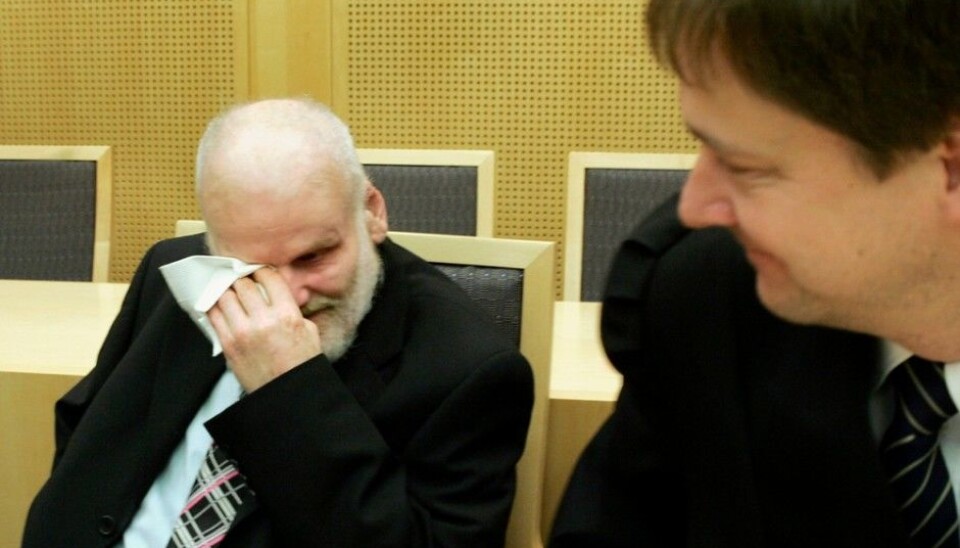
Risk for more convictions of the innocent
Legal safeguards for persons with mental disabilities in Norway are too weak, according to a researcher. A counsel for victims thinks the Norwegian judicial system has learned little from the conviction of the innocent man, Fritz Moen.
Many Netflix viewers round the world have binge-watched the American TV mini-series “Making a Murderer”, a documentary about what appears to be a compound miscarriage of justice and wrongful police proceedings in the State of Wisconsin.
Norwegian viewers might forget that one of the most serious modern cases of an innocent man being convicted in Europe happened on their home turf.
Fritz Moen spent over 18 years locked up in institutions for the rape and murder of two women. The severely disabled man turned out to be completely innocent.
Moen was acquitted of one of the rape/homicides in 2004. But the second acquittal did not come until 2006, after another man with a police record for violence made a deathbed confession to both killings. But Fritz Moen had died in 2005.

In the wake of this case, several research projects have looked into the legal safeguards for the disabled.
A recent issue of the Scandinavian Journal of Disability Research presents some of these studies. They were financed by a research fund provided by the estate of Fritz Moen.
Research fund
Prior to his death, Moen left his entire estate to Signo Conrad Svendsens Senter in Oslo, an institution for the deaf and deaf-blind where he lived after prison and until his death. Moen was posthumously awarded NOK 20 million, upwards of $2 million, from the Norwegian State.
A decision was made to start a research fund. The goal was to contribute to research and dissemination of information about legal safeguards for persons with disabilities – with special focus on the rights of deaf and hearing-disabled persons, as Moen was deaf and partly paralysed and had difficulties communicating.
Cases with similarities to Moen’s

Patrick Kermit at the Norwegian University of Science and Technology (NTNU) and Terje Olsen of the Nordland Research Institute have contributed with a study of what happens when deaf and hearing disabled persons encounter the judicial system.
The particulars of some of the cases Terje Olsen and Kermit found in their research resemble those in the Fritz Moen affair.
One example was that of a deaf man who was beaten up in a taxi queue. When the police arrived on the scene they questioned perpetrators. They tried to interrogate the deaf man without any help from an interpreter. They didn’t believe he had a disability and told him he would be charged with “playing deaf”.
At the police station, the deaf victim’s friend, also hearing disabled, explained to the cops that they needed to formulate their questions on paper. The charges were dropped against the victim after an interpreter was finally brought in.
Problems with interpretation
Olsen’s study shows that Norway has an extensive interpreter service, which is necessary to secure the legal safety of deaf people. But the judicial system can put too much faith in such interpreters. Even in Moen’s appeal in a court in 2001, licensed court interpreters initially misunderstood him as saying he was “guilty” of the crime.
“Deaf interpreting is often viewed as something with machine-like precision. But some hidden communication barriers are evident,” says Olsen.
We take many concepts for granted within the judiciary. But legal jargon is a foreign language when it is translated to sign language.
“The language of law is highly developed for nuances. But when an interpreter translates it to sign language, which lacks all the concepts, misunderstandings occur.”
Little headway since Moen case
Following the miscarriage of justice which had ruined the life of Fritz Moen, the Norwegian Government appointed a committee to evaluate the case. An Official Norwegian Report [NOU] was made but Olsen thinks little has happened since.
“The only concrete change was a letter from the Director General of Public Prosecution stipulating that audio and video recordings should be made of interrogations of particularly vulnerable persons.”
When the appellate trial was held in 2001 and Moen was re-interrogated, the proceedings were filmed. This revealed that Moen was not talking about himself, but about the killer when he commented on his guilt. This video was probably what tipped the scale in favour of Moen when he was acquitted.
The issue of whether such audio-visual recordings are routinely made at Norwegian police stations is the theme of another research project from Nordland Research Institute and NTNU.
New miscarriages of justice possible
Attorney Helge Hjort at the firm of Hestenes og Dramer & co has provided legal service to persons with disabilities in several court cases.
He thinks that the Fritz Moen case shook up the Norwegian judicial system but he has his doubts about how much has been actually learned.
“We still see major communication problems in encounters with persons with disabilities. When I read transcripts from police interrogations I often see that many misunderstandings occur in communication with the suspect.”
Hjort is not asserting that this is leading to convictions of the innocent.
“But the potential is certainly there.”
Hard for the police
Hjort has experience representing persons with autism spectrum disorders.
“For instance, a person with Asperger’s syndrome has another type of logic than you or me. He or she will have a more spontaneous and intuitive way of comprehending things and communicating. It can be hard for police to fully understand that this is a person who reasons in a different way.”
In these cases the use of an interpreter is no solution. And Hjort thinks much of the country’s interpreter services are amateurish and inferior.
The attorney has the impression that videos with audio recordings have become more common in interrogations as well as trials in the wake of the Moen case.
But he points out that Norway has far to go before all legal proceedings get recorded.
-------------------------------------
Read the Norwegian version of this article at forskning.no
Translated by: Glenn Ostling


































